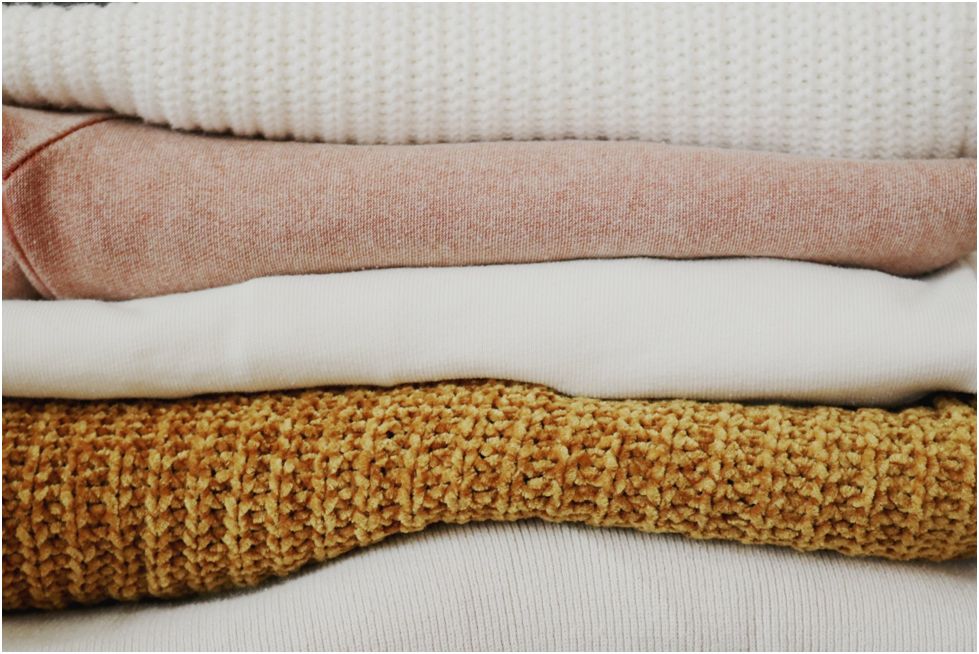
Source: https://www.pexels.com/photo/piled-of-folded-textiles-1937336/
Clothing industries use circular knitting machines to produce articles of clothing massively. Although these knitting machines have unique properties that help workers do their work efficiently and help the industries to increase their production rate. The use of knitting machines still poses problems and limitations on some occasions.
Through this circular knitting machine guide, we want to help you determine the causes and have an idea of the solutions of the faults and defects in knitting.
Common Knitting Defects: Their Causes and Solutions
Barre
Barres on knitted fabrics are unnoticeable. However, if you have a keen eye, you can spot an unusual repetitive visual pattern of stripes that are parallel to the knitted, woven fabric. Irregular yarns are the real culprit for this knitting defect; its texture and characteristic inconsistency provides unevenness to the knitted fabric.
There are several causes where yarns are a hindrance to high-quality knitted fabrics. It can be the variation of the hairiness, tension, linear density, fiber micronaire, and twists of the yarns. Among these countless causes of barres, there is only one solution to this problem: yarn quality control.
The industry should regulate the yarns they use to produce high-quality knitted fabrics. Some industries apply a Uster test before they place it on the circular knitting machine. The Uster test measures the level of imperfection and irregularity in yarns.
Cotton contamination or stains
It is unsettling to see fabrics with stains. Some stains are unnoticeable on gray cotton fabric, yet it appears when illuminated with light. Circular knitting machine defects mainly cause these dark stains. It may be a defective oil circuit, inadequate or excessive oil on the machine.
The contamination or stain may also be caused by insects that lay on the cotton flowers. Other than these causes, improper handling, unclean containers, and the lack of awareness of the operator may also be possible causes.
Some stains are impossible to remove. However, there are some cases of cotton contamination or stains that can easily be removed. It is recommended for operators to handle the circular knitting machines properly by following the precautions on its temperature and adequate use of oil. Moreover, operators need to check the oil circuit regularly.
The industry can also set up laboratory dyeing tests on knit samples before production to detect faults on the circular knitting machine.
Dropped Stitches
Dropped stitches are recurrent openings in stips of knitted fabrics. The defect is commonly caused when the yarn is hooked on a defective needle latch. Moreover, the improper setting for the yarn guide, insufficient tension on yarns, long stitches, or incorrect yarn threading may also lead to dropped stitches.
The solutions for dropped stitches are more on adjusting the setting of the circular knitting machine. To troubleshoot the following problems, the operator needs to reset the yarn-guide to its precise configuration. Moreover, needle change and readjustments to the take-down and dial position should also be considered.
Fabric Spirality
Fabric spirality is the deformity of the plain knitted fabric, and the wales are usually not perpendicular to the fabric courses. The leading cause of fabric spirality is the performance between the rotation of the circular knitting machine and the direction of the yarn twist.
It is best to prevent this knitting defects through yarn quality control. Industries should only use yarn twists that are not more than 700 tr/m. Moreover, reducing the number of feeders on the circular knitting machine can also help prevent this problem. Some industries use the Z-twist yarn on circular knitting machines that allow operators to observe the rotation direction of the needles.
Holes in Fabric
Holes in fabrics is a significant upset for the clothing industry. It is a result of broken yarns on a needle feed that hinders from knitting to occur. If the yarn-guide is blocked or it is not set correctly, it will cause fluffs on the knitting creel. Moreover, to avoid holes, the yarn should have adequate tension and texture. High tension and dryness on yarns may result in holes in the fabric.
When holes happen, the operator should carefully inspect the yarn before placing it on the circular knitting machine. Considering the characteristic of the yarn is a big step in avoiding this kind of defect. It is best to use yarns that have lower hairiness, and check its bobbins. Moreover, air humidification and protective creel filter help prevent fluff accumulation.
Conclusion
Circular knitting machines is a great help for the fabric industry, and it helps massive production of clothes at a lower production cost. However, problems and defects can still occur. This circular knitting machine guide aims to help operators and industries to prevent knitting problems and defects. Carefully regulating and inspecting the yarns and maintaining the circular knitting machine is one of the ways to avoid knitting problems.
Chris Mcdonald has been the lead news writer at complete connection. His passion for helping people in all aspects of online marketing flows through in the expert industry coverage he provides. Chris is also an author of tech blog Area19delegate. He likes spending his time with family, studying martial arts and plucking fat bass guitar strings.